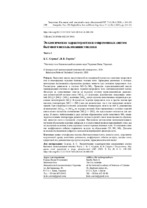Экологические характеристики современных систем бытового использования топлива. Часть 1

Date
2020Publisher
Another Title
Environmental Characteristics of Modern Systems of Domestic Use of Fuel. Part 1
Bibliographic entry
Сорока, Б. С. Экологические характеристики современных систем бытового использования топлива. Часть 1 = Environmental Characteristics of Modern Systems of Domestic Use of Fuel. Part 1 / Б. С. Сорока, В. В. Горупа // Энергетика. Известия высших учебных заведений и энергетических объединений СНГ. – 2020. – № 4. – С. 340-354.
Abstract
Выполнен анализ экологической составляющей процессов сжигания природного газа в атмосферных горелках бытовых газовых плит. Проведены расчетные и экспериментальные исследования образования вредных веществ при сжигании природного газа. Рассмотрено равновесие в системе NO–O2–NO2. Проведен термодинамический анализ трансформации системы в процессе горения природного газа (метановоздушной смеси). Несмотря на существенное (иногда на порядки) отличие термодинамически равновесных концентраций оксидов азота [NOx]eq от локальных, фактических замеренных значений [NOx] = [NO] + [NO2], величины [NO]eq могут служить качественным индикатором реальных концентраций [NOx]. В процессах горения природного газа и других топлив при высоких температурах [NO] >> [NO2] как для равновесных, так и для замеренных концентраций. При умеренных и низких локальных температурах, вплоть до 600 К, равновесные концентрации [NO2]eq → [NO]eq по порядку величин. При определенных составах горючей смеси может наступить соотношение [NO2] >> [NO], что представляет опасность для здоровья. В связи с наблюдаемым в ряде случаев образованием особо токсичного NO2 анализируется влияние температуры реакции и состава горючей смеси на возможность образования диоксида азота в продуктах сгорания. Предложена методология экспериментального изучения образования вредных выбросов и создан огневой компьютеризованный стенд для исследования сжигания углеводородных газов в горелках бытовых плит. Установлено влияние коэффициента избытка первичного воздуха на образование СО, NO, NO2. Доказана возможность появления выбросов с высокой концентрацией диоксида азота.
Abstract in another language
The analysis of the environmental component of the processes of natural gas burning in atmospheric burners of domestic gas stoves has been carried out. The computational and experimental studies of the harmful substances formation by combustion of natural gas have been performed. The chemical equilibrium of the NO–O2–NO2 system was considered. The thermodynamic analysis of transformation of the system during a process of natural gas (methane-air mixture) combustion has been tested. Despite an essential (sometimes – by the order(s)) difference between the thermodynamically equilibrium concentration of the nitrogen oxides [NOx]eq and the local, actually measured values [NOx] = [NO] + [NO2], the [NO]eq values could be served as the qualitative indicators of actual values of [NOx] concentrations. In the combustion processes natural gas and other fuels combustion at high temperatures [NO] >> [NO2] for both equilibrium and measured concentrations. By moderate and low local temperatures up to 600 K the equilibrium concentration [NO2]eq → [NO]eq in order of magnitude. Under some compositions of burning mixture the correlation could be set as [NO2] >> [NO], resulting in great danger for the human health. With regard to the formation of particularly toxic NO2 effluents observed in some cases, an influence of the reaction temperature and the composition of the combustible mixture on the possibility of nitrogen dioxide formation in the combustion products have been analyzed. A methodology for the experimental study of the harmful emissions formation has been proposed while the computerized firing rig has been developed for studying the combustion of hydrocarbon gases in burners of household stoves. An influence of the coefficient of primary air excess on the СО, NO, NO2 formation has been revealed and the possibility of appearance the emissions of a high concentration of nitrogen dioxide has been demonstrated.
View/
Collections
- № 4[7]
